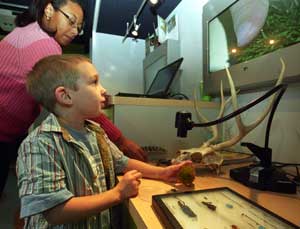“Guys, come look — there’s a lobster!”
A dozen kindergarten students from Delmar-Harvard Elementary rush forward to inspect. Welcome to the MySci Investigation Station, a mobile science classroom designed to foster early childhood interest in the sciences.

Draped in bold, colorful graphics — a grasshopper and a prairie dog; an octopus floating amidst pale green waves of seaweed — the custom-built, 37-foot-long semi-trailer is the centerpiece of MySci, a comprehensive K-2 science experience developed thanks to a $3.7 million grant from the Monsanto Fund to WUSTL’s Science Outreach program.
Since April, more than a dozen faculty and students from the Visual Communications Research Studio (VCRS), part of the Sam Fox School of Design & Visual Art, have spearheaded design of the MySci materials (including the name), as well as the Investigation Station and accompanying curriculum guides.
Curricular input was provided by Science Outreach faculty, area teachers, graduate students from the Department of Education in Arts & Sciences and educators at the Saint Louis Zoo, the St. Louis Science Center and the Missouri Botanical Garden. Students and faculty from the Olin School of Business helped research costs and operations.
“If you want to engage kids with science, you need to get them involved in the act of observation,” said D.B. Dowd, an illustrator and professor of visual communications, who led the design team with Heather Corcoran, assistant professor of visual communications, and Scott Gericke, director of the VCRS.
“Our research suggests that an inquiry-based approach and physical engagement work best with this audience,” Dowd continued. “You have to create experiences that allow them to participate and discover things in a hands-on way.”
The finished Investigation Station, unveiled Oct. 26 and now touring St. Louis-area schools, is divided into three zones, each boasting a variety of tactile, interactive displays.
The Missouri Woodland Room, entered through a fold-down ramp at the rear of the station, features a wall-sized forest scene complete with floor-to-ceiling sculpted tree. Three additional environments — prairie, ocean and desert — are depicted on a three-sided turning mural.
An illustrated library of more than 50 different animals, ranging from toads, skunks and squirrels to birds, spiders and starfish, are printed on attachable, magnetically backed vinyl.
“The idea was to let the kids manipulate the wall and create their own environments,” Dowd said. “The variable environments permit teachers to pose simple questions in ways that actively engage students. Instead of just telling them that fish live in water, teachers can say ‘Here’s a fish. Where do you think the fish might live?'”
The Specimen Room houses a pair of video microscopes as well as drawers and display cases filled with plants, minerals, bones, feathers and other touchable samples, most drawn from the science center’s collection. The Cave Room — a foam-covered replica of a Missouri limestone cave — allows students to crawl and slide amidst stalactites and stalagmites while learning about native animals, rocks and insects.
“Science Outreach programs use current research in education, which indicates that allowing students to investigate real objects and ask questions is most effective,” said Victoria L. May, director of science outreach. “The design of the Investigation Station visually pulls kids in and then helps them get excited about learning more through hands-on experiences.”
The accompanying curriculum — aligned with Missouri Grade Level Expectations and guided through the design and development process by Corcoran — focuses on three areas of study: plants, animals and the earth.
For each topic, two units have been developed, one for kindergarten and one unit for first and second grade. Each unit consists of pre-visit activities (including a teachers’ kit), activities conducted aboard the Investigation Station and post-visit activities.
“The goal was to create a clear, accessible way for teachers to understand MySci’s inquiry-based approach, as well as to provide background information about the subjects and specific lessons,” Corcoran said.
“Curriculum books ask a series of open-ended questions for teachers to pose to students. They also make aggressive use of images and pictorial information design.”
In addition to Delmar-Harvard, the Investigation Station has already visited Lemasters School in North County, Old Bonhomme Elementary in Olivette and Drummond Elementary in Pattonville. Upcoming stays are planned for Dunbar Elementary in St. Louis City and Central Elementary in Wellston.
A typical “residency” will run Monday through Thursday, with Friday dedicated to preparing for the next stop.
“We’re delighted that our students get to experience the Investigation Station,” concluded Victoria Gonzalez-Rubio, principal of Delmar-Harvard. “Many of our students live in an urban environment and do not get to experience nature outside of their own back yards.
“This visit allows them to learn about Missouri nature and science in a way that is interactive and fun.”